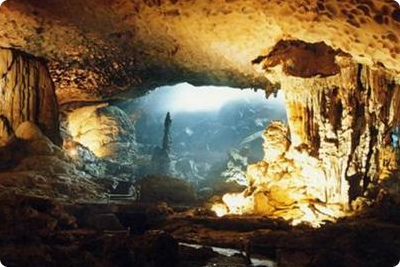Dau Go Grotto

The grotto is divided into three main parts.
Crossing the first chamber, one enters the second chamber through a narrow passage. The light here is mysterious, and new images appear in the stone. It makes us having a fear and be inquisitive.
The third chamber of the grotto is widely opened. At the end of the grotto is a well of clear water. Looking up in the dim light we recognize that surrounded is the image of an ancient citadel and a scuffle of elephants, horses, man with bristly sword and spear. All are making a rush and be petrified suddenly.
The name Driftwood Grotto came from a popular story of the resistance war against the Yuan - Mongolian aggressors. In a decisive battle, Trân Hung Ðao was given the order to prepare many ironwood stakes here, to be planted on the riverbed of Bach Ðang River. The remaining wooden pieces found in the grotto have given it its present name.
And the name Giâu Gô is associated with the legend that General Trân Hung Ðao (1226-1300) hid ironwood stakes in preparation for the Bach Ðang battle against the Yuan-Mongolian invaders.
If the Thiên Cung Grotto is monumental and modern (in its natural form), then Driftwood Grotto is solemn, but also grandiose. In "Marvels of the World," published in France in 1938, the author called the grotto "Grotte des merveilles" (a site of many marvels)
In the first chamber, in the very middle of the grotto, is a colossal pillar supporting the large vault. On the top of the pillar, there appears to be a monk draped in a long, dark cloak, with his right hand clasping a cane.
The second chamber is narrow. Here, the stalactites look smaller but more graceful. One feels like going to a pagoda with a monk in meditation so that one steps more gently.
The third chamber features high stone columns out of which nature has carved images of a large kingdom, of heroes and soldiers holding swords and spears rushing up, of war elephants and horses or lions, etc. All of them suddenly was petrified and remained there for good.
In 1917, Emperor Khai Ðinh came to visit the grotto, and amazed by the beauty of the place, ordered the erection of an engraved stone stele singing the praises of Ha Long Bay and the grotto. Today, it remains to the right-hand side of the entrance.














